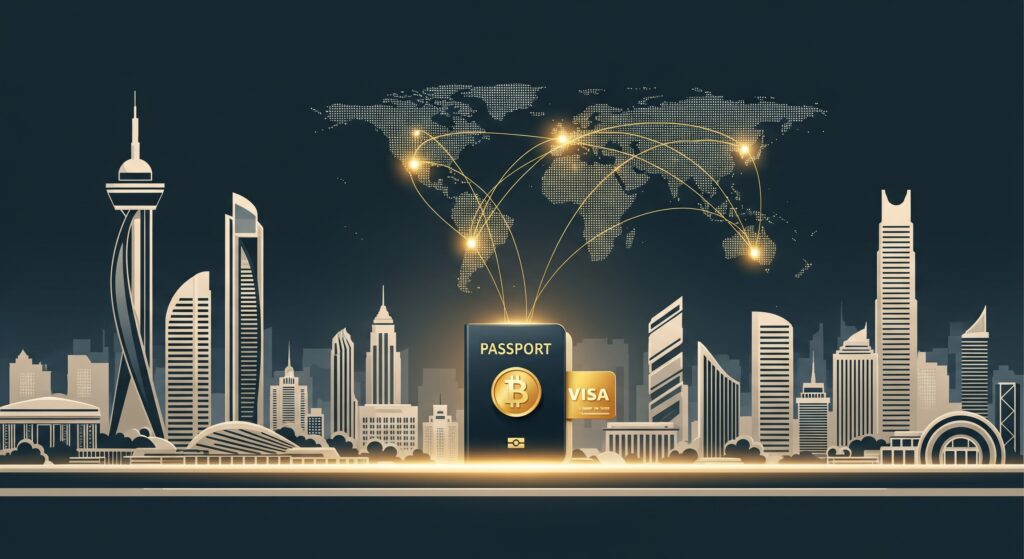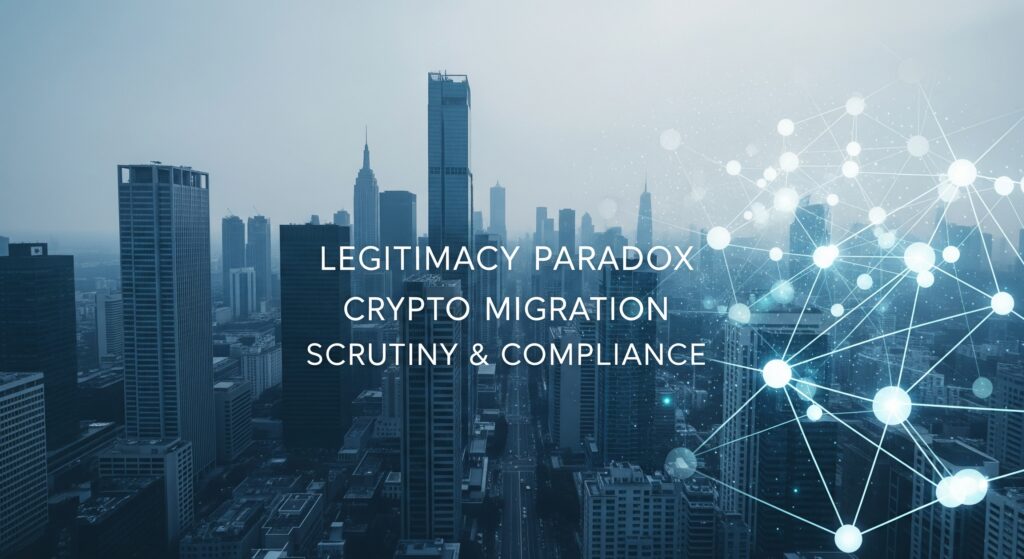Crypto Noah’s Ark: The Strategic Migration of the Digital Elite in a World of Uncertainty

Introduction: The Coming Flood and the Call to a New World
A great flood is upon the old world. It is not a deluge of water, but a convergence of forces threatening the foundations of the global economic and political order. A storm of incoherent and often punitive regulation batters innovators. A tide of persistent inflation erodes wealth and trust in sovereign currencies. A tsunami of technological change, centered on decentralized networks, is rendering legacy systems obsolete for a new class of digital natives. In this turbulent environment, a modern exodus is taking shape.
Pay 0% Tax Legally — Start Your Tax-Free Strategy Today
Even in low-tax jurisdictions, most investors still overpay.
Our elite partner tax law firms specialize in advanced legal structures that can reduce your effective tax rate to as low as 0%, fully compliant, audit-ready, and tailored to your profile.
Crypto-friendly. International. Proven.
This report argues that the phenomenon of “crypto expatriation” has evolved far beyond the simplistic narrative of tax optimization. It is now a strategic migration of a new digital elite—a global cohort of entrepreneurs, developers, investors, and visionaries who have built their fortunes and their futures on the blockchain. They are not merely fleeing; they are pioneering. Like the prospectors of the 19th-century Gold Rush, they are abandoning an old world of regulatory instability and diminishing financial sovereignty to seek new frontiers. They are building and boarding a new kind of ark, not of gopher wood, but of code. These “Arks” are sovereign-friendly jurisdictions, emerging ecosystems where innovation is not a threat to be managed but a resource to be cultivated, and where financial autonomy is not a loophole but a right.

This analysis will navigate the complex currents of this global migration. It will first deconstruct the powerful “push” factors driving this digital diaspora from the established economic centers of the West. It will then illuminate the “pull” factors and practical mechanisms of the journey, detailing how crypto-native wealth is being transformed into global mobility. Through a series of data-backed archetypes, we will profile the passengers on this ark, from the pragmatic trader to the ideological purist. Finally, the report will chart a course through the emerging “Promised Lands, the key crypto havens, before concluding with a forward-looking assessment of the risks, challenges, and ultimate future of this new world being built on the digital frontier.
Part I: The Old World: Why the Pioneers Are Fleeing
The migration of the digital elite is not a reaction to a single grievance but a strategic response to a confluence of systemic pressures. The decision to uproot a life and a business is driven by a powerful combination of regulatory chaos, aggressive taxation, and the fundamental erosion of economic and personal sovereignty in the world’s traditional power centers.
1.1 The Regulatory Maelstrom: A Tale of Two Continents
The primary catalyst for this global exodus is not the tax rate itself, but the suffocating fog of regulatory uncertainty. For innovators and builders in the digital asset space, who require clear rules to invest capital and develop products, the current environment in many Western nations has become untenable. The divergent and often contradictory approaches of the world’s two largest economic blocs, the United States and the European Union, have created a powerful incentive to seek shores where the rules of the road are clearly marked.

The US Approach: Regulation by Enforcement
The United States, despite being a hub of technological innovation, lacks a comprehensive federal legislative framework for digital assets. This has resulted in a “scattered regulation strategy” where governance is dictated not by clear statutes but by the aggressive and often conflicting enforcement actions of various agencies. The Securities and Exchange Commission (SEC) and the Commodity Futures Trading Commission (CFTC) are locked in a protracted jurisdictional battle, leaving the industry’s most fundamental question unanswered: is a given crypto asset a security under the SEC’s purview or a commodity governed by the CFTC?
This “regulation by enforcement” approach creates a climate of profound uncertainty and legal risk. Companies find it impossible to innovate with confidence when the legal classification of their core product could be retroactively challenged in court. As one legal expert noted, this has been a major impediment for years because companies simply “don’t know how to comply properly”. The result is a chilling effect on development and a strong push for entrepreneurs to relocate to jurisdictions that have already done the legislative work to provide clarity.
The EU Approach: Comprehensive but Constrictive
In stark contrast to the American void, the European Union has implemented the world’s first comprehensive regulatory framework for crypto-assets, known as MiCA (Markets in Crypto-Assets Regulation), which took full effect on December 30, 2024.4 MiCA is a landmark piece of legislation that provides a unified set of rules across the bloc, offering the legal clarity that the US market lacks. This push for coherence is a direct lesson learned from the 2008 financial crisis, which revealed the systemic dangers of fragmented national oversight and regulatory arbitrage.
However, while MiCA is welcomed for its clarity, its substance is deeply rooted in traditional financial regulation. It imposes strict, banking-style compliance requirements on crypto-asset service providers (CASPs), including capital adequacy standards, stringent risk management frameworks, and, critically, local subsidiary mandates. These requirements, while intended to protect consumers and ensure stability, can be philosophically and operationally at odds with the decentralized, borderless nature of many crypto projects, creating a new set of “push” factors for those seeking a less rigid environment.
This Great Divergence between the US and the EU, one offering chaos, the other constriction, has created a vacuum. It has made regulatory clarity a key competitive advantage in the global race to attract crypto capital and talent, pushing innovators to seek a “third way” in jurisdictions that have crafted bespoke, balanced, and supportive frameworks. This is not a flight from regulation, but a flight from bad regulation. The most sought-after havens are not lawless frontiers but well-governed states that understand the technology they are regulating. This search for a stable and predictable environment, a “certainty premium,” is a primary driver of the migration, explaining the appeal of robustly regulated hubs like the UAE and Switzerland over more volatile alternatives.
1.2 The Taxman Cometh: From Ambiguity to Aggression
Layered on top of the regulatory chaos is a tax environment that is often punitive in its rates and bewildering in its complexity. For individuals and businesses whose wealth is denominated in digital assets, the tax regimes of many Western nations represent a direct and significant financial drain.

US Tax Treatment: Property and Paperwork
The U.S. Internal Revenue Service (IRS) does not treat cryptocurrency as currency. Instead, it is classified as “property” for tax purposes. This seemingly simple classification has profound consequences. Every time a cryptocurrency is sold for cash, traded for another crypto, or used to purchase goods and services, a taxable event occurs. Gains are subject to capital gains tax. If the asset was held for less than one year, the gain is considered short-term and taxed at the individual’s ordinary income tax rate, which can be as high as 37%. Only assets held for over a year qualify for the more favorable long-term capital gains rates of 0%, 15%, or 20%.
This system not only imposes a heavy tax burden but also creates a significant compliance headache. Taxpayers must meticulously track the cost basis and sale price of every single transaction, reporting them on complex forms like Form 8949 and Schedule D. The introduction of the new Form 1099-DA for broker reporting in 2025 will only increase the flow of data to the IRS, tightening the net on crypto holders.
EU Tax Fragmentation: A Patchwork of Policies
The European Union, in line with its fragmented regulatory history, has no standardized tax policy for crypto-assets. The treatment varies dramatically from one member state to another, with tax rates on profits ranging from 0% to over 50%. This creates a compliance nightmare for any individual or business operating across borders and a powerful incentive for relocation within the bloc or outside of it.
A stark contrast can be seen between Belgium and Germany. Belgium is considered one of the worst countries for crypto taxation, imposing a 33% tax on speculative capital gains and treating income from professional trading as regular income, which can be taxed at rates up to 50%. Germany, on the other hand, offers one of the most favorable regimes in Europe: cryptocurrencies held for more than one year are completely exempt from capital gains tax. This disparity creates clear winners and losers and makes tax-driven migration a highly rational economic decision. The aggressive policies of some nations act as a powerful brain drain, pushing their most mobile and innovative citizens—and their capital—towards more welcoming shores. This outflow simultaneously weakens the domestic innovation ecosystem of the departing country while strengthening that of its more forward-thinking competitors, creating a self-fulfilling prophecy of economic and technological decline.
1.3 The Erosion of Sovereignty: Economic Instability and the Inflationary Tide
For a growing number of crypto pioneers, particularly those from outside the G7, the push to migrate is not just strategic but existential. Decades of economic mismanagement, chronic inflation, currency devaluation, and the imposition of capital controls in their home countries have made cryptocurrency less of an investment and more of a lifeline.

The Flight from Fiat and the Inflation Hedge
In regions like Latin America, trust in traditional financial institutions and national currencies has been deeply eroded. Citizens are turning to crypto “not for speculation, but to escape inflation”. Countries with a history of hyperinflation, such as Argentina and Venezuela, have become hotbeds of grassroots crypto adoption as people seek a reliable store of value to protect their life savings from debasement.
This is where Bitcoin’s core value proposition as a safe-haven asset, or “digital gold,” becomes most apparent. Its fundamental properties—a decentralized network with no single point of control, a transparent and predictable issuance schedule, and a hard-capped supply of 21 million coins—stand in stark contrast to fiat currencies, which can be printed in unlimited quantities at the whim of governments and central banks. During times of economic crisis or geopolitical turmoil, this digital scarcity provides a powerful hedge against inflation and government manipulation, a narrative that gained significant traction globally during the economic uncertainty of the COVID-19 pandemic.
The Argentinian Case: A Crucible of Crypto Adoption
Argentina serves as a potent case study. The nation has been plagued by economic crises and soaring inflation for decades, with the annual rate reaching a staggering 211% at the end of 2023. While recent austerity measures have dramatically lowered the monthly rate, the long-term trauma of wealth destruction has created a highly crypto-literate population. For Argentinian software developers and tech professionals, who are part of a thriving local tech scene, holding their savings in the peso is untenable. Many work remotely for foreign companies specifically to earn in stable currencies like the US dollar or in crypto, bypassing the local financial system entirely. For them, migration to a stable economic hub like Portugal is not just about career advancement; it is a quest for the basic financial security that their home country cannot provide.
Part II: Building the Ark: The New Mechanisms of Global Mobility
The migration of the digital elite is powered by a new and rapidly evolving set of tools and legal pathways. The abstract desire for sovereignty is being translated into concrete reality through formal investment migration programs that are increasingly adapted to the unique nature of crypto wealth. This section demystifies the journey from being a crypto HODLer to becoming a global citizen, detailing the construction of the modern-day ark.

2.1 From HODLer to Global Citizen: The Rise of Crypto Investment Migration
What was once a niche concept has now become a formalized and viable pathway: using cryptocurrency holdings to secure residency or citizenship in a foreign country. This process, known as crypto investment migration, is a specialized form of residency and citizenship by investment (RCBI) where digital assets like Bitcoin (BTC), Ethereum (ETH), or stablecoins (USDT) are the source of qualifying funds.
Instead of the traditional method of transferring fiat currency to invest in government bonds, real estate, or business ventures, applicants commit funds held in crypto. This is a crucial distinction from simply moving to another country while holding digital assets. Crypto investment migration involves a formal legal process, complete with regulatory compliance, asset verification, and a clear paper trail, all designed to bridge the on-chain world with the off-chain requirements of sovereign states.
The advantages of this route are compelling. Crypto transactions are inherently fast and borderless, which can significantly accelerate the investment phase of the residency process. For individuals who are “crypto-rich but fiat-poor,” it provides a direct mechanism to translate their digital wealth into global mobility. Furthermore, for those in countries facing economic instability or currency devaluation, it offers a powerful hedge, allowing them to preserve and transfer value far more efficiently than through traditional banking channels.
2.2 The Golden Visa Playbook: Pathways to a New Passport
Residency and Citizenship by Investment (RCBI) programs, often called “Golden Visas,” are the primary vehicles for this strategic migration. A growing number of nations, recognizing the immense capital held by the crypto community, have adapted their programs to attract this new source of investment.

- Portugal’s Golden Visa: This has been one of the most popular pathways to the European Union. It traditionally required a qualifying investment, with the €500,000 venture capital/private equity fund option becoming the standard after real estate was phased out. The program offers a five-year path to residency and eventual citizenship with a minimal physical presence requirement of just seven days per year on average. In a groundbreaking development, new investment funds have emerged that are specifically designed for the crypto-native investor. These CMVM-regulated funds allow applicants to meet the €500,000 threshold by investing in vehicles that offer direct exposure to Bitcoin ETFs, such as BlackRock’s IBIT, or a balanced portfolio of digital assets and traditional Portuguese fixed income. This creates a seamless bridge, allowing an investor to maintain exposure to the crypto market while securing an EU passport.
- El Salvador’s “Freedom Visa”: In a bold, ideologically-driven move, El Salvador has created a crypto-native path to citizenship. The “Freedom Visa” program requires a non-refundable donation of US$1 million, payable in Bitcoin (BTC) or Tether (USDT), directly to the government. This program eschews traditional investment routes in favor of a direct contribution to the nation-building project of the world’s first “Bitcoin country,” appealing directly to crypto purists.
- The UAE’s Residency Program: The United Arab Emirates, particularly Dubai, has positioned itself as a premier global hub for business and wealth. While it does not offer a direct path to citizenship, it provides long-term residency visas (often for 5 or 10 years) through qualifying investments in real estate or the establishment of a local business. The ease of obtaining residency, combined with its 0% personal income tax and a clear regulatory framework for virtual assets, makes the UAE one of the most desirable and stable destinations for crypto entrepreneurs and investors.
- Malta’s MEIN Program: For those seeking a top-tier EU passport directly, Malta offers its “Granting of Citizenship for Exceptional Services by Direct Investment” (MEIN) program. This requires a significant financial commitment, including a substantial non-refundable donation to the government and a real estate investment or lease. While the investment itself must be made in fiat, Malta’s reputation as the “Blockchain Island” and its sophisticated financial ecosystem make it a strategic choice for high-net-worth individuals who can compliantly convert their crypto holdings to fund the application.
2.3 The Gauntlet of Compliance: Proving the Provenance of Digital Wealth
Boarding the ark is not a simple matter of showing up with a wallet full of crypto. The single most critical and challenging part of the entire process is proving the legitimacy of that wealth. These new havens are seeking to attract innovators and capital, not to become conduits for illicit finance. As such, the bar for compliance is exceptionally high.

The journey to freedom from the perceived overreach of legacy systems paradoxically requires submitting to an even more intense level of financial scrutiny. The crypto ethos, born from a desire for privacy and pseudonymity, collides with the demands of the traditional legal and financial world. To convert on-chain value into real-world mobility, one must first prove their financial purity to the very gatekeepers of the old system. This is the legitimacy paradox of crypto migration.
- KYC/AML is Non-Negotiable: Every reputable RCBI program requires applicants to undergo rigorous Know Your Customer (KYC) and Anti-Money Laundering (AML) checks. Governments and their partner financial institutions must have absolute assurance that the invested funds are clean and have no connection to sanctions, scams, or the dark web.
- The Source of Funds (SoF) Hurdle: This is the gauntlet that every applicant must run. They must provide a clear, comprehensive, and auditable history of how they accumulated their crypto wealth. This documentation can include:
- Early Purchase Records: Proof of buying crypto on exchanges in the early days.
- Mining History: Logs and receipts from mining operations.
- Trading Statements: Complete transaction histories from exchanges.
- Wallet Histories: On-chain data showing the movement of funds.
- Proof of Employment/Business: Evidence of being paid in crypto for legitimate work or services.
- The Rise of On-Chain Forensics: To verify these claims, a new industry of specialized service providers has emerged. Blockchain analytics firms like Chainalysis and Elliptic are increasingly being engaged to perform on-chain forensic analysis, tracing the path of an applicant’s assets from their source to their current wallet. These firms can issue a “clean asset report,” which is fast becoming a mandatory document for high-value applications, providing an independent, expert validation of the funds’ legitimacy.
- The Holding Period Requirement: Many jurisdictions also impose a holding period, often requiring that assets have been held for at least 6 to 12 months. This is to demonstrate that the wealth is the result of a long-term investment strategy, not the proceeds of recent, highly speculative trading or illicit activities.
The sheer complexity of this process—navigating international tax law, crypto-to-fiat conversions, and the intense scrutiny of SoF documentation—is beyond the scope of a traditional immigration lawyer or wealth manager. This has given rise to a new class of professional: the crypto migration advisor. These hybrid experts, fluent in the languages of both blockchain and international law, act as the essential “shipbuilders” of the modern ark, guiding clients through the treacherous waters between the on-chain and off-chain worlds.
Part III: The Passengers: Archetypes of the Digital Ark
The crypto migration is not a monolithic movement but a diverse flotilla carrying passengers with varied motivations, strategies, and destinations. To understand the human dimension of this trend, we can examine a series of data-backed archetypes. Each profile represents a distinct “push” and “pull” dynamic, illustrating the multifaceted nature of the new digital diaspora.
3.1 Profile 1: The Pragmatic Trader – From Brussels to Dubai
This archetype is a successful, active cryptocurrency trader whose primary motivation is rational economic calculation. Their journey is a flight from punitive taxation and uncertainty towards financial optimization and operational freedom.

The “Push” – Belgium’s Punitive System:
Operating from Brussels, the trader faces one of Europe’s most challenging tax environments for crypto. Their frequent trading activity means their gains are likely classified as speculative “miscellaneous income,” subject to a flat 33% capital gains tax, plus local communal taxes. If their activity is deemed professional, the burden becomes even heavier, with profits taxed at progressive income tax rates ranging from
25% to 50%, in addition to social security contributions. This high tax burden directly erodes their profitability. Compounding this is a climate of regulatory ambiguity. Belgium has been slow to implement the EU’s MiCA framework and, as of early 2025, had no domestically registered crypto-asset service providers (CASPs), forcing reliance on foreign platforms and creating operational uncertainty.
The “Pull” – The UAE’s Certainty and Lifestyle:
Dubai presents an almost perfect solution. The United Arab Emirates offers 0% personal income tax and 0% capital gains tax for individuals, a policy that extends to active crypto traders. This single factor represents a massive increase in retained earnings. Beyond the tax incentive, the UAE provides what Belgium lacks: regulatory certainty. The Virtual Assets Regulatory Authority (VARA) has established a clear and robust framework, giving businesses a stable environment in which to operate. While the UAE has introduced a 9% corporate income tax, this does not apply to the personal trading gains of an individual resident. Although the cost of living in Dubai is higher than in Brussels, particularly for rent, the complete absence of income tax often results in a significantly higher net disposable income.35 The move is a clear-headed business decision to maximize wealth preservation.
The Journey:
The trader’s path would involve establishing tax residency in the UAE, a process that typically requires spending at least 183 days in the country. This is most commonly achieved by obtaining a residency visa, either through a real estate investment or by setting up a small company in one of the UAE’s many economic free zones.
3.2 Profile 2: The Resilient Builder – An Argentinian Developer’s Move to Portugal
This archetype is a skilled software developer or tech entrepreneur whose migration is driven by a search for stability, opportunity, and a higher quality of life. Their journey is an escape from systemic chaos.

The “Push” – Argentina’s Economic Chaos:
Based in Buenos Aires, the developer is part of a vibrant and talented tech community but is hampered by the country’s chronic economic instability. Persistent high inflation relentlessly erodes the value of their local-currency salary and savings. The broader business environment is fraught with challenges, including a scarcity of local venture capital, inadequate digital infrastructure in some areas, and a volatile regulatory landscape. To survive, many Argentinian developers already operate in a quasi-expatriate mode, working remotely for foreign companies to earn in stable currencies like the US dollar or crypto, effectively insulating themselves from the local economy.
The “Pull” – Portugal’s Tech Ecosystem and Quality of Life:
Portugal offers a compelling alternative. It boasts a booming tech ecosystem, particularly in Lisbon and Porto, which has attracted major international companies like Google and AWS, all actively recruiting skilled talent. For the developer, this means access to a dynamic job market within a stable, safe, and affordable European country. The quality of life is high, with a culture that values work-life balance.
A key historical incentive was Portugal’s Non-Habitual Resident (NHR) tax regime, which offered a 20% flat tax on Portuguese-sourced income and a tax exemption on most foreign-sourced income for ten years. While this program was officially phased out for new applicants in 2024, its spirit lives on. It has been replaced by a new
Tax Incentive for Scientific Research and Innovation, which continues to offer a 20% flat tax rate for individuals in eligible high-value professions, including many tech roles. This demonstrates Portugal’s ongoing strategic commitment to attracting top tech talent. Furthermore, while Portugal now taxes short-term crypto gains at 28%, long-term holds of over a year remain tax-free, offering a far more predictable and stable environment than Argentina.
The Journey:
The developer could leverage Portugal’s specialized visa programs, such as the Tech Visa or the Digital Nomad Visa, which are specifically designed to fast-track the immigration process for highly skilled professionals from outside the EU. The ultimate prize is the clear pathway to permanent residency and, after five years, eligibility for Portuguese citizenship and an EU passport.
3.3 Profile 3: The Collective Visionary – A DAO’s Quest for Legal Sanctuary in The Bahamas
This archetype is not an individual but an organization: a Decentralized Autonomous Organization (DAO). Its migration is not about lifestyle but about a fundamental legal necessity: finding a “legal wrapper” to exist in the real world without exposing its members to catastrophic risk.

The “Push” – The Liability of Formlessness:
A DAO is a new form of organization that runs on blockchain protocols, governed by its members through token-based voting. While it exists on-chain, it must inevitably interact with the off-chain world—to hire contributors, sign partnership agreements, manage treasury assets, or hold intellectual property. In most legal systems, an unincorporated organization of individuals working towards a common business purpose is treated as a “general partnership“. This has a terrifying implication: every member of the DAO, down to the smallest token holder, could face unlimited personal liability for all of the DAO’s debts and legal obligations. A landmark U.S. court case, CFTC v. Ooki DAO, affirmed this dangerous precedent, establishing that DAOs can be sued and their members held liable.
The “Pull” – The Bahamas’ DARE Act:
Jurisdictions are now competing to solve this problem by offering bespoke legal structures, or “wrappers,” for DAOs. The Bahamas has emerged as a leading contender with its comprehensive Digital Assets and Registered Exchanges (DARE) Act, 2024.49 This legislation is one of the world’s most advanced regulatory frameworks for the digital asset industry. It provides clear rules for everything from exchanges and custody to staking services and stablecoins. By enabling a DAO to register as a recognized legal entity within this framework, The Bahamas provides the DAO with “separate legal personality.” The DAO itself can now own property, enter into contracts, and be held liable in court, shielding its individual members from personal risk.
This search for the optimal legal wrapper is a new frontier in corporate law, where law is being adapted to accommodate code. The Bahamas is in direct competition with other innovative jurisdictions, most notably the Marshall Islands, which passed its own DAO Act allowing DAOs to register as special-purpose LLCs (either for-profit or non-profit) with features like member privacy and the option for algorithmic management instead of a traditional board of directors. For a DAO’s founders, the strategic decision involves a careful comparison of these pioneering legal frameworks to find the one that best aligns with their mission while providing the strongest liability shield for their community.
3.4 Profile 4: The Ideological Purist – The Technopunk’s Dream
The final archetype is motivated not by money or stability, but by pure ideology. This individual is a modern incarnation of the Cypherpunk, the intellectual and spiritual ancestor of the crypto movement.

The “Push” – The Betrayal of the Open Internet:
The Cypherpunk’s worldview is shaped by the principles laid out in Eric Hughes’s 1993 A Cypherpunk’s Manifesto: “Privacy is necessary for an open society in the electronic age… We must defend our own privacy if we expect to have any… Cypherpunks write code”. They view the trajectory of the modern world—with its increasing government surveillance, corporate data harvesting, financial censorship, and the erosion of online anonymity—as a betrayal of the original promise of a free and open internet. Their migration is an act of political dissent.
The “Pull” – The Search for True Sovereignty:
This individual is drawn to the philosophy of techno-libertarianism, which advocates for using technology to maximize individual liberty and minimize the power of centralized states. Their goal is not just a low-tax jurisdiction but a philosophical haven that respects and protects digital sovereignty. They are staunch advocates for self-custody wallets, which give them absolute control over their own assets without reliance on any third-party custodian. They are the natural citizens and builders of the theoretical concepts that represent the ultimate “exit”:
- Network States: As envisioned by Balaji Srinivasan, these are online communities that form around a shared purpose, build a crypto-based economy, crowdfund physical territory around the globe, and eventually seek diplomatic recognition as new, decentralized countries.
- Seasteading: The creation of permanent, autonomous communities on floating platforms in international waters, operating outside the jurisdiction of any existing nation.
While these concepts remain on the frontier, jurisdictions that embrace their underlying principles are highly attractive to this archetype. El Salvador’s radical experiment of adopting Bitcoin as legal tender is not just a policy decision but a powerful ideological signal that resonates deeply with the technopunk’s quest for a world where money and state are separate.
The existence of these diverse archetypes reveals that crypto expatriation is a spectrum of motivations, ranging from the purely pragmatic to the deeply philosophical. A trader’s needs are different from a developer’s, which are different from a DAO’s or a cypherpunk’s. Understanding where a potential migrant falls on this spectrum is the critical first step in providing any meaningful strategic advice.
Part IV: The Promised Lands: A Global Atlas of Crypto Havens
The decision to migrate is followed by an even more critical choice: where to go. The world now offers a diverse landscape of potential destinations, each with a unique value proposition. This section provides a structured, comparative analysis of the key “Promised Lands,” moving from individual stories to a strategic global overview.

4.1 Defining the Destination: A Framework for “Crypto-Friendliness”
A truly “crypto-friendly” jurisdiction offers a holistic environment that supports innovation, wealth, and lifestyle. Based on the primary drivers of migration, a robust framework for evaluating these havens rests on three essential pillars:
- Pillar 1: Tax Clarity & Advantage: This is the most visible metric. It encompasses not only low or zero capital gains and income taxes on crypto-related activities but, more importantly, a tax code that is clear, stable, and predictable. Jurisdictions with well-defined rules provide the certainty needed for long-term financial planning.
- Pillar 2: Regulatory Certainty & Support: This is arguably the most crucial pillar for businesses and serious investors. It involves having a clear, bespoke legal framework for digital assets that defines their legal status and provides a transparent path for licensing and operation. Proactive and knowledgeable regulators, like the UAE’s VARA or Switzerland’s FINMA, are a major pull factor.
- Pillar 3: Ecosystem & Infrastructure: A favorable legal regime is insufficient on its own. A top-tier haven must also possess a thriving tech and startup ecosystem, reliable access to crypto-friendly banking services, a high quality of life, political stability, and tangible government support for the blockchain industry.
4.2 The Tiers of Sanctuary: A Comparative Overview
Using this framework, the world’s crypto havens can be categorized into distinct tiers, each offering a different balance of risk and reward.
- Tier 1: The Premier Hubs (United Arab Emirates, Switzerland, Singapore): These nations represent the “gold standard.” They offer unparalleled political and economic stability, world-class infrastructure, deep pools of capital, and sophisticated, well-established regulatory frameworks. They are the preferred destination for institutional players, large-scale crypto businesses, and high-net-worth individuals who prioritize security and predictability above all else. The trade-off is a very high cost of living and high barriers to entry, both financially and in terms of compliance.
- Tier 2: The European Contenders (Portugal, Malta, Germany): These countries provide a strategic gateway to the vast EU market. They offer an attractive balance, combining favorable (though evolving) tax regimes with strong and growing tech scenes, high quality of life, and the legal certainty of operating within the EU. They represent a compelling middle ground for those who seek European residency without the extreme costs of Switzerland or the perceived risks of more experimental jurisdictions.
- Tier 3: The Bold Experiments (El Salvador, Caribbean Nations, Panama): This tier is characterized by highly aggressive and innovative policies. They often feature zero-tax regimes for crypto, direct integration of digital assets into their economies (such as Bitcoin as legal tender in El Salvador), and streamlined residency or citizenship programs. These destinations are highly attractive to ideological purists, digital nomads, and investors seeking maximum tax efficiency. The potential trade-offs can include greater political volatility, developing infrastructure, and less established international reputations.
4.3 Essential Table 1: Comparative Analysis of Top Crypto Jurisdictions
To provide a clear, at-a-glance decision-making tool, the following table compares key destinations across the most critical metrics for a potential crypto migrant.
| Country | Individual Capital Gains Tax (Long-Term Crypto) | Individual Income Tax | Primary Residency Pathway | Regulatory Framework Status | Innovation & Lifestyle Score (1-5) |
| United Arab Emirates | 0% | 0% | Real Estate / Business Setup | Clear & Active (VARA) | 5 |
| Switzerland | 0% (for individuals) | Low to Moderate (Cantonal) | Business Setup / Lump Sum Taxation | Clear & Established (FINMA) | 5 |
| Singapore | 0% | Progressive (0-22%) | High-Skilled Visa / Investor Programs | Clear & Active (MAS) | 5 |
| Portugal | 0% (held >1 year) | Progressive (up to 53%) | Golden Visa (Funds) / D7 / Digital Nomad Visa | Evolving (MiCA Implemented) | 4 |
| Malta | 0% (if foreign sourced & not remitted) | Remittance-based / Progressive | Residency by Investment / MEIN (Citizenship) | Clear & Established (VFA Act) | 4 |
| El Salvador | 0% | 0% (on crypto) | “Freedom Visa” ($1M Donation) | Bitcoin Legal Tender | 2 |
| Cayman Islands | 0% | 0% | Residency by Investment (Real Estate) | Clear & Active (VASP Act) | 3 |
| Germany | 0% (held >1 year) | Progressive (up to 45%) | Skilled Worker Visa | Evolving (MiCA Implemented) | 4 |
4.4 Essential Table 2: Tax Treatment of Specific Crypto Activities
The term “crypto tax” is not monolithic; the treatment varies significantly based on the specific activity. This table provides a more granular comparison for different investor and user profiles.
| Jurisdiction | Long-Term Hold (>1yr) Sale | Short-Term Trade (<1yr) Sale | Staking/Mining Rewards (as income) | Crypto-to-Crypto Swap | Gifting/Inheritance |
| USA | 0%/15%/20% Capital Gains Tax | Ordinary Income Tax (10-37%) | Taxed as Ordinary Income | Taxable Event (Capital Gains) | Gift Tax exclusion applies ($19k for 2025) |
| Germany | 0% Tax Free | Ordinary Income Tax (if >€600 profit) | Taxed as Income | Taxable Event (triggers holding period) | Gift/Inheritance Tax may apply |
| Portugal | 0% Tax Free | 28% Capital Gains Tax | Taxed as Investment Income (28%) or Business Income (progressive) | Non-Taxable Event | 10% Stamp Duty |
| UAE | 0% Tax Free | 0% Tax Free | 0% Tax Free (for individuals) | 0% Tax Free | No Gift/Inheritance Tax |
| Switzerland | 0% Tax Free (for individuals) | Tax-free unless deemed professional trader | Taxed as Income | Generally Tax-Free (for individuals) | Cantonal Gift/Inheritance Tax applies |
| Belgium | 33% Capital Gains Tax (if speculative) | 33% Capital Gains Tax (if speculative) | Taxed as Professional Income (25-50%) | Taxable Event (Capital Gains) | Gift Tax applies |
These comparisons reveal critical nuances. For instance, Portugal’s policy of not taxing crypto-to-crypto swaps makes it highly attractive for active DeFi users, even if short-term gains into fiat are taxed. Germany’s one-year holding rule provides a clear and simple path to tax-free gains for long-term investors. The UAE’s blanket 0% tax on all individual activities provides the ultimate simplicity and financial benefit.
The status of a “crypto-friendly” nation, however, is not static. Portugal’s 2023 introduction of taxes on short-term gains serves as a critical case study. It demonstrates that favorable policies, often enacted by one government to attract mobile capital, can be politically vulnerable and subject to reversal by a subsequent administration or in response to international pressure. This underscores a crucial point for any strategic migrant: the decision cannot be based solely on the laws of today. It requires a sophisticated analysis of a country’s political stability, economic trajectory, and long-term commitment to its pro-innovation stance. The most important question is not “What is the tax rate now?” but “How likely is this environment to remain stable for the next decade?”
Conclusion: The Next Flood and the Next Frontier
Pay 0% Tax Legally — Start Your Tax-Free Strategy Today
Even in low-tax jurisdictions, most investors still overpay.
Our elite partner tax law firms specialize in advanced legal structures that can reduce your effective tax rate to as low as 0%, fully compliant, audit-ready, and tailored to your profile.
Crypto-friendly. International. Proven.
The migration of the digital elite, the boarding of the Crypto Noah’s Ark, is a defining trend of our time. It is a rational response to a world of growing uncertainty, a strategic repositioning of capital and talent towards new centers of gravity. Yet, as the pioneers set sail for these promised lands, they must recognize that the journey is far from over. The arks themselves float on a volatile sea, and new storms are gathering on the horizon.

5.1 The Gathering Storm: The Risks of Paradise
These new havens are not invulnerable. Their long-term viability is subject to significant external pressures and internal risks that could threaten their status.
- The FATF/OECD Hammer: The most formidable threat comes from powerful international organizations, chiefly the Financial Action Task Force (FATF) and the Organisation for Economic Co-operation and Development (OECD). These bodies are the enforcers of the global financial order, and their campaigns against money laundering and for global tax transparency put immense pressure on any jurisdiction perceived as a “tax haven.” A negative review or placement on the FATF’s “greylist” can severely damage a country’s reputation and access to the global financial system. This constant pressure forces havens to continually tighten their compliance and reporting requirements, which can gradually erode the very advantages—such as privacy and low administrative burden—that made them attractive in the first place.
- Political Instability: Favorable crypto policies are often the product of a specific, forward-thinking government. As the fluctuating regulatory stances in the United States demonstrate, a change in political leadership can dramatically and rapidly alter a country’s approach to digital assets. The long-term sustainability of a crypto haven is therefore only as strong as its domestic political consensus. Migrants must assess whether a country’s pro-crypto stance is a deeply embedded national strategy or a transient policy subject to the winds of electoral change.
- The Bubble Risk: There is a legitimate question as to whether these emerging hubs are building diversified, sustainable economies or are simply inflating localized bubbles with mobile crypto capital. An economic model heavily reliant on attracting crypto wealth could be vulnerable to a severe, prolonged bear market in digital assets. The resilience of these havens has yet to be tested by a true crypto winter in their mature, regulated form.
5.2 Beyond the Horizon: Seasteading, Network States, and the Future of Sovereignty
The current migratory trend may be just the first wave of a much more profound movement. It is an early expression of a deep-seated desire, enabled by technology, to experiment with new forms of social, economic, and political organization. The ultimate frontier is not just to find a better country, but to build a new one.
This is the radical vision behind concepts like the Network State, as proposed by technologist Balaji Srinivasan. He theorizes a path for ideologically aligned online communities to crowdfund physical territory, build a crypto-native economy, and eventually achieve diplomatic recognition as a new form of decentralized, geographically distributed nation. It represents the logical endpoint of the Cypherpunk dream: a full “exit” from the legacy system.
Parallel concepts like Seasteading—the creation of autonomous, permanent communities on floating platforms in international waters—push this frontier even further, seeking to build new societies on the literal blank slate of the high seas. While these projects face immense logistical, economic, and legal hurdles, they signify the incredible ambition of a generation that believes it can code new countries into existence.
5.3 An Open Question: Sustainable Havens or Ephemeral Bubbles?
This report concludes not with a definitive prediction, but with a strategic question for the pioneers, investors, and builders of the digital age. Will today’s Crypto Arks prove to be durable vessels, capable of navigating the storms of international regulation and evolving into permanent, thriving hubs of global innovation? Or are they beautiful but ephemeral bubbles, destined to be popped by the next wave of political change or economic turmoil?

The answer remains unwritten. What is certain, however, is that the forces driving this migration—the quest for financial sovereignty, regulatory stability, and personal liberty—are only intensifying. In a world of accelerating change and uncertainty, the search for a safe harbor is no longer a niche pursuit for a handful of tech enthusiasts. It is a defining challenge of the 21st century. For the digital elite, choosing the right ark, and the right crew of expert advisors to help them navigate these uncharted waters, will be the most critical strategic decision they make.